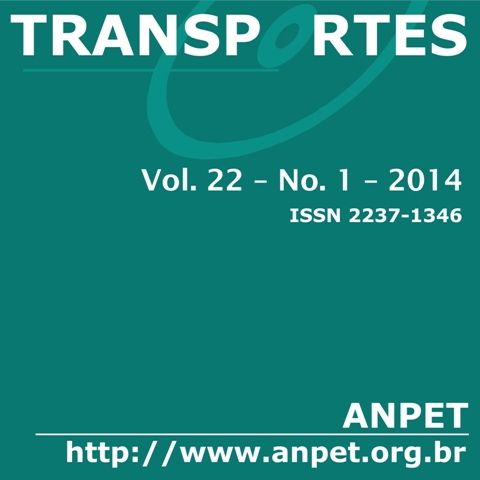A Variable Neighborhood Search metaheuristic for the mass transit crew rostering problem
DOI:
https://doi.org/10.14295/transportes.v22i1.698Keywords:
Crew rostering problem, mass transit, metaheuristic.Abstract
One of the last stage from public transportation planning concerns to defining the scale of urban bus drivers for short term period, called Crew Rostering Problem (CRT). This problem aims to generate sequences of daily shifts, includ-ing weekdays, Saturdays and Sundays, respecting labor laws and operational constraints. Moreover, a good crew roster should provide a better division of workload among the crews and still to reduce the overtime costs paid by the company. The model proposed in this paper is able to generate solutions satisfying a fixed scheme called 5/1 of day-off, beyond the labor laws and operational constraints imposed by the company. The Variable Neighborhood Search metaheuristic (VNS) was implemented using different neighborhood structures, varying the number of modifications performed on the current solution. The implementation was tested with data from a midsize company and the results show significant improvements compared to the solution adopted by the company.Downloads
References
Ahuja, R. K.; Magnanti, T. L. e Orlim, J. B. (1993) Network Flows: Theory, Algorithms, and Applications. Prentice Hall, New Jersey.
Bianco, L.; Bielli, M.; Mingozzi, A.; Ricciardelli, S. e Spadoni, M. (1992) A heuristic procedure for the crew rostering problem. European Journal of Operations Research, v. 58, n. 2, p. 272-283. DOI: 10.1016/0377-2217(92)90213-S.
Caprara, A.; Monaci, M. e Toth, P. (2003). Models and algorithms for a staff scheduling problem. Mathematical Programming, 98(1-3), 445–476. DOI: 10.1007/s10107-003-0413-7
Carraresi, P. e Gallo, G. (1984) A multi-level bottleneck assign-ment approach to the bus drivers rostering problem. European Journal of Operational Research, v. 16, n. 2, p. 163–173. DOI: 10.1016/0377-2217(84)90071-7.
Ernst, A. T.; Jiang, H.; Krishnamoorthy, M. e Sier, D. (2004a) Staff scheduling and rostering: A review of applications, methods and models. European Journal of Operational Research, v. 153, p.3-27. DOI: 10.1016/S0377-2217(03)00095-X.
Ernst, A. T.; Jiang, H.; Krishnamoorthy, M.; Owens, B. e Sier, D. (2004b) An annotated bibliography of personnel scheduling and rostering. Annals of Operations Research, v. 127, p. 21-144. DOI: 10.1023/B:ANOR.0000019087.46656.e2.
Lin, S. e Kernighan, B. W. (1973) An effective heuristic for the traveling salesman problem. Operations Research 21, 498–516, 1973. DOI: 10.1287/opre.21.2.498.
Mayrink, V. T. M. e Silva, G. P. (2013) Optimization of crew ros-tering assignment for public transport systems. Journal of Transport Literature, v. 7, p. 192-213. DOI: 10.1590/S2238-10312013000300009.
Mesquita, M.; Moz, M.; Paias, A.; Paixão, J.; Pato, M. e Respício, A. (2011) A new model for the integrated vehicle-crew-rostering problem and a computational study on rosters. Journal of Schedul-ing, v. 14, p.319–334. DOI: 10.1007/s10951-010-0195-8.
Mladenović, N. e Hansen, P. (1997) Variable Neighborhood Search. Computers and Operations Research v. 24, n 11, p. 1097-1100. DOI: 10.1016/S0305-0548(97)00031-2.
Moz, M.; Respício, A. e Pato, M. V. (2009). Bi-objective evolu-tionary heuristics for bus driver rostering. Public Transport, v. 1, n.3, p. 189–210. DOI: 10.1007/s12469-009-0013-x.
Nurmi, K.; Kyngas, J. e Post, G. (2012). Driver rostering for bus transit companies. Engineering Letters, v. 19, n. 2, p. 125–132.
Pato M. e Moz, M. (2008) Solving a bi-objective nurse rerostering problem by using a utopic Pareto genetic heuristic. Journal of Heuristics, v. 14, p. 359–374. DOI: 10.1007/s10732-007-9040-4.
Toffolo, T. A.; Souza, M. J. F. e Silva, G. P. (2005) Resolução do Problema de Rodízio de Tripulações de Ônibus Urbano via Simu-lated Annealing e Iterated Local Search. Anais do XIX Congresso de Pesquisa e Ensino em Transportes, ANPET, v. 2, p. 657-668.
Yunes, T. H.; Moura, A. V. e Souza, C. C. (2005). Hybrid Col-umn Generation Approaches for Urban Transit Crew Management Problems. Transportation Science, v. 39, n. 2, p. 273-288. DOI: 10.1287/trsc.1030.0078.
Downloads
Published
How to Cite
Issue
Section
License
Authors who submit papers for publication by TRANSPORTES agree to the following terms:
- The authors retain the copyright and grant Transportes the right of first publication of the manuscript, without any financial charge, and waive any other remuneration for its publication by ANPET.
- Upon publication by Transportes, the manuscript is automatically licensed under the Creative Commons License CC BY 4.0 license. This license permits the work to be shared with proper attribution to the authors and its original publication in this journal.
- Authors are authorized to enter into additional separate contracts for the non-exclusive distribution of the version of the manuscript published in this journal (e.g., publishing in an institutional repository or as a book chapter), with recognition of the initial publication in this journal, provided that such a contract does not imply an endorsement of the content of the manuscript or the new medium by ANPET.
- Authors are permitted and encouraged to publish and distribute their work online (e.g., in institutional repositories or on their personal websites) after the editorial process is complete. As Transportes provides open access to all published issues, authors are encouraged to use links to the DOI of their article in these cases.
- Authors guarantee that they have obtained the necessary authorization from their employers for the transfer of rights under this agreement, if these employers hold any copyright over the manuscript. Additionally, authors assume all responsibility for any copyright infringements by these employers, releasing ANPET and Transportes from any responsibility in this regard.
- Authors assume full responsibility for the content of the manuscript, including the necessary and appropriate authorizations for the disclosure of collected data and obtained results, releasing ANPET and Transportes from any responsibility in this regard.










